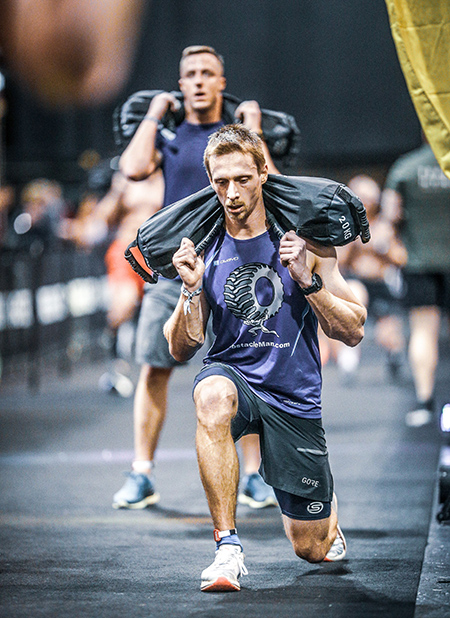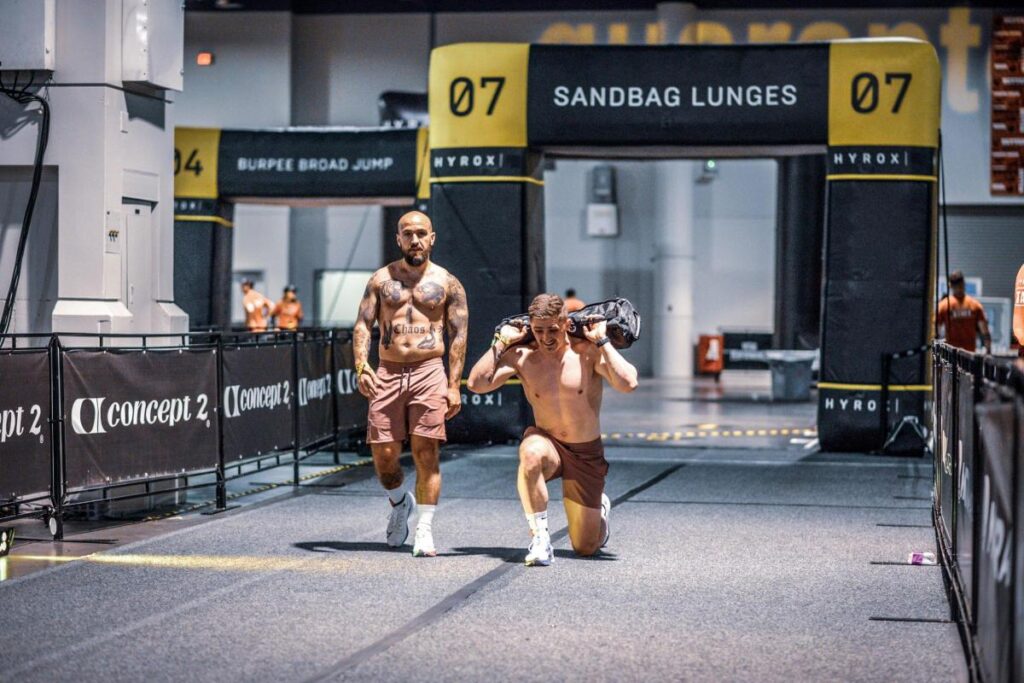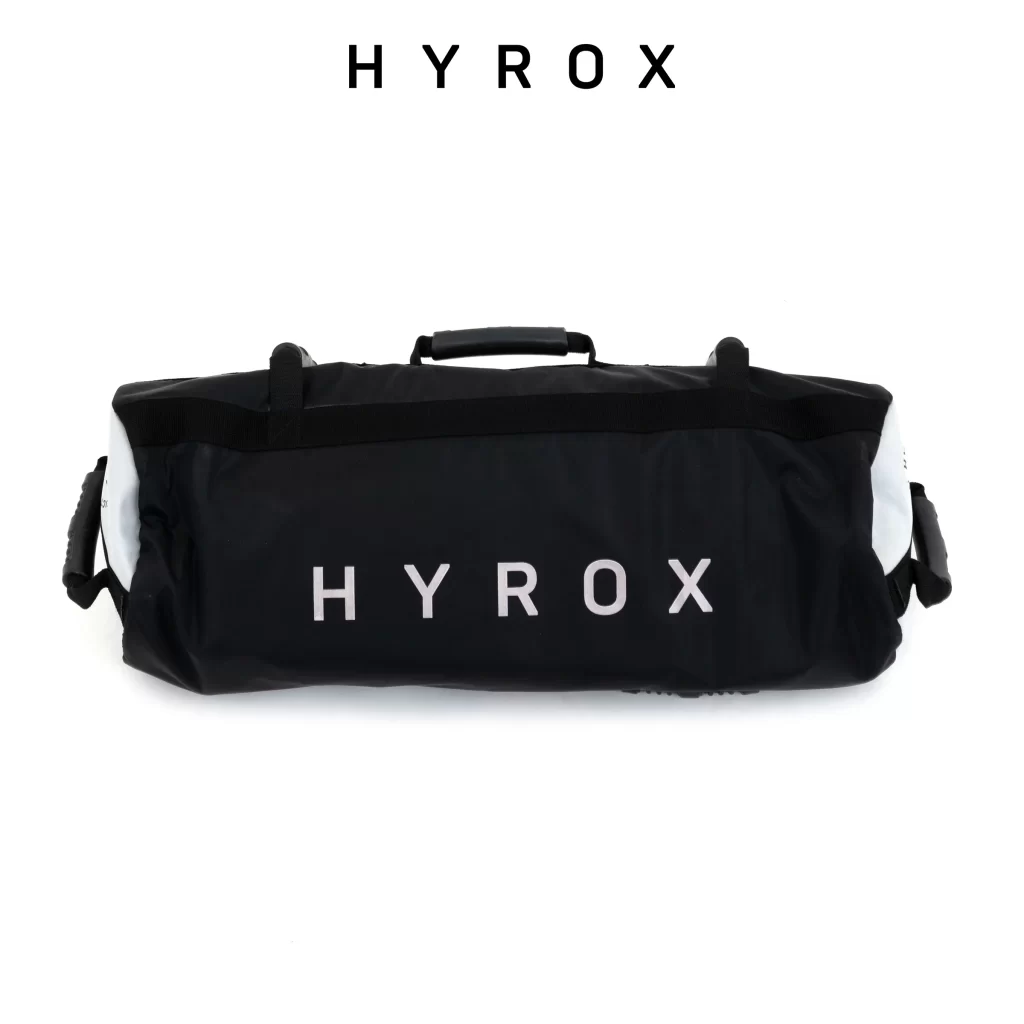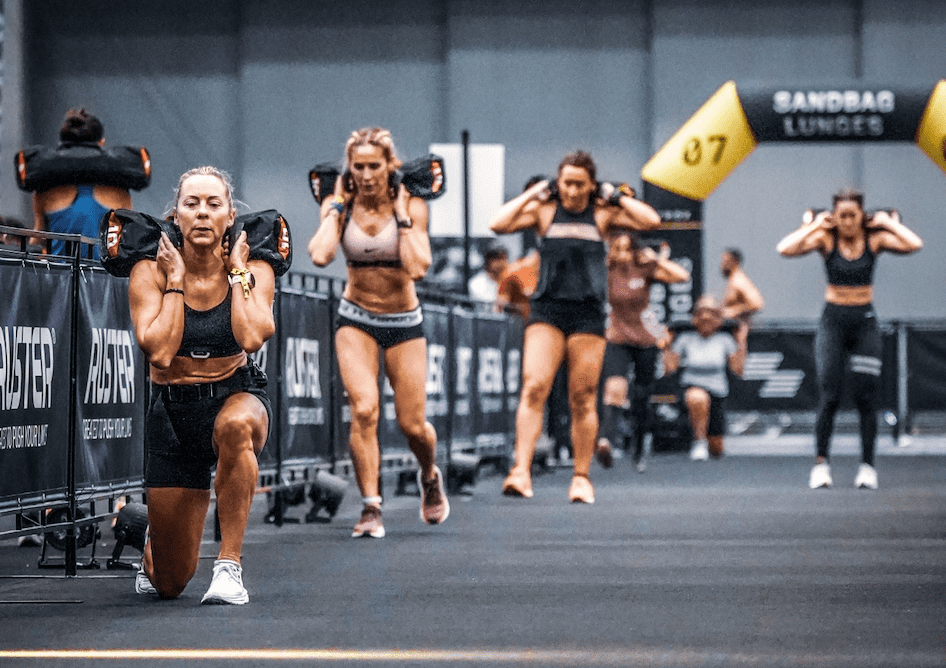Next up in our series of articles on HYROX workout tips and strategies to improve each HYROX station, is station 7, SANDBAG LUNGES. Here you need to complete 100m of HYROX sandbag lunges in totality.
Below is a video from HYROX trainer Jade Skillen giving some top tips for the HYROX sandbag lunges:
HYROX Sandbag LungeS Specifications (weights and distance)
The HYROX sandbag lunges criteria have the following variations:
- Women’s Category:
Distance: 100 meters
Sandbag Weight: 10kg - Women Pro Category:
Distance: 100 meters
Sandbag Weight: 20kg - Men’s Category:
Distance: 100 meters
Sandbag Weight: 20kg - Men Pro Category:
Distance: 100 meters
Sandbag Weight: 30kg - Mixed Doubles:
Distance: 100 meters
Sandbag Weight: 20kg - Women Doubles:
Distance: 100 meters
Sandbag Weight: 10kg - Men Doubles:
Distance: 100 meters
Sandbag Weight: 20kg - Women Relay:
Distance: 100 meters
Sandbag Weight: 10kg - Men Relay:
Distance: 100 meters
Sandbag Weight: 20kg - Mixed Relay:
Female Members – Distance: 100 meters, Sandbag Weight: 10kg
Male Members – Distance: 100 meters, Sandbag Weight: 20kg

HYROX Sandbag Lunges Rules
It is important to read and know the rulebook for your category to avoid any unnecessary penalties.
Below are the standards from the rulebook for SINGLES:
The HYROX Sandbag Lunges begins and ends with the removal/return of the sandbag from the marked area next to the start/finish line.
- The athlete must lift up the sandbag without assistance and place it across both shoulders.
- The athlete starts standing tall with both feet behind the line before starting their first lunge across the start line.
- During each lunge, the trailing knee must clearly touch the ground.
- Each repetition ends with knees and hips fully extended.
- Lunges must be alternating i.e. alternating knees touching the ground.
- The athlete can either lunge continuously or stop after each lunge with both feet parallel on the ground.
- Taking any steps or shuffles between repetitions is not permitted.
- The station is complete, once the athlete lunges across the finish line and returns the sandbag to the marked area.
- If the athlete violates any of the above-mentioned points, the repetition becomes invalid and in the second warning, the athlete receives a 5 m distance penalty.
- The sandbag must remain on both shoulders at all times and it is not permitted to put the sandbag down at any time during the workstation.
- Removing the sandbag from the shoulders will result in a 5 m penalty. The second time will result in a disqualification.
- Distance 100 m (unless penalties are assessed)

Section 1: Understanding HYROX Sandbag Lunges
Introduction to HYROX Sandbag Lunges: Sandbag lunges are a fundamental component of the HYROX competition, requiring participants to walk 100m while carrying a sandbag on their shoulders. This exercise is designed to test not only lower body strength but also stability, endurance, and mental fortitude. Understanding the unique challenges and nuances of HYROX sandbag lunges is essential for optimizing performance in this specific element of HYROX.
Key Components of HYROX Sandbag Lunges:
- Sandbag Weight: The weight of the sandbag is a crucial factor and varies based on gender and category (this is shown above). It’s imperative to practice with the exact weight or heavier you’ll encounter in HYROX to build familiarity and adapt your strength accordingly.
- Balance and Stability Requirements: Unlike traditional lunges, the inclusion of a sandbag introduces an element of imbalance. Maintaining stability becomes more challenging as the sandbag shifts during each step, engaging not only the major leg muscles but also the stabilizing muscles throughout your core.
- Uneven Load Distribution: Carrying the sandbag on your shoulders introduces an uneven load on your upper body. This requires precise coordination and strength distribution to prevent strain on one side and maintain an effective and controlled lunge pattern.
Execution of HYROX Sandbag Lunges:
- Starting Position: Begin with the sandbag placed securely on your shoulders. Ensure an even distribution of weight to prevent unnecessary strain on one side of your body.
- Foot Placement: Take controlled steps with a moderate stride length. Avoid overextending, as this can compromise balance. Precise foot placement is critical to maintaining stability, especially considering the uneven load of the sandbag.
- Posture: Maintain an upright posture throughout the lunge. Engage your core to support your spine and prevent unnecessary strain. A straight and stable posture is fundamental to efficient sandbag lunges.
- Stride Control: The control of your stride is essential. A measured and consistent stride not only optimizes stability but also contributes to overall efficiency, especially considering the prolonged nature of the HYROX event.
Challenges and Considerations:
- Uneven Terrain: HYROX events often take place in varied settings, introducing the challenge of uneven terrain. Practicing sandbag lunges on different surfaces prepares you for potential obstacles, ensuring adaptability during the competition.
- Endurance Demands: HYROX Sandbag lunges are not just about strength; they also test your endurance. You will have already run 7km and have completed 6 functional stations – SkiErg, sled push, sled pull, burpee broad jumps, rowing and farmers carries. Following the sandbag lunges, you will have a 1km run and the wall balls station left to finish. The continuous nature of the exercise, coupled with the added weight, necessitates a strategic approach to pacing and energy conservation.
Understanding the intricacies of HYROX sandbag lunges lays the foundation for targeted training and efficient performance in the HYROX competition. In the following sections, we will delve into specific techniques, training strategies, and mental approaches to help you master this challenging element.
In the video below Aaron O’Brien gives some top tips for the HYROX sandbag lunges:
Section 2: Techniques to Improve HYROX Sandbag Lunges Efficiency
1. Sandbag Placement and Grip:
- Optimal Sandbag Positioning: The correct placement of the sandbag is pivotal for efficient lunges. Position it securely on your shoulders, ensuring an even distribution of weight. Experiment with the placement to find the most comfortable and stable position for your body type.
- Balanced Grip Dynamics: Hold the sandbag with a balanced grip, utilizing both hands. Avoid gripping too tightly, as this can lead to unnecessary tension in your arms and shoulders. A balanced grip contributes to controlled movement and conserves energy.
2. Stride Length and Posture:
- Moderate Stride Length: Take measured steps with a moderate stride length. Avoid overreaching, as this can compromise balance and stability. A controlled stride length ensures that each step is deliberate and contributes to the overall efficiency of the movement.
- Upright Posture Maintenance: Throughout the lunge, maintain an upright posture. Engage your core muscles to support your spine. A straight and stable posture not only optimizes muscle engagement but also minimizes the risk of strain or injury.
3. Controlled Descent and Ascent:
- Smooth Descent: As you descend into each lunge, prioritize smooth and controlled movements. Resist the urge to rush the descent, allowing your muscles to engage fully. A deliberate descent minimizes the impact on joints and enhances overall effectiveness.
- Explosive Ascent: The ascent from the lunge is a powerful, explosive movement. Push off with your front foot, engaging the muscles of your legs and core. This dynamic movement not only propels you forward but also optimizes the muscle engagement required for efficient sandbag lunges.
4. Foot Placement Precision:
- Mindful Foot Placement: Focus on precise foot placement with each step. The uneven load of the sandbag requires careful attention to balance. Ensure that your steps are deliberate and that your feet land securely to maintain stability throughout the movement.
- Adaptability to Terrain: Practice sandbag lunges on various surfaces to enhance adaptability. HYROX events may feature different terrains, and being accustomed to uneven surfaces prepares you for potential challenges during the competition.
5. Breathing Synchronization:
- Rhythmic Breathing Pattern: Develop a rhythmic breathing pattern that synchronizes with your lunge movements. Consistent and controlled breathing not only supports cardiovascular efficiency but also helps maintain focus and composure during the demanding exercise.
- Breath Awareness: Stay mindful of your breath throughout the lunge. Awareness of your breathing can contribute to mental focus and help regulate your energy expenditure, especially in the context of the prolonged efforts required in HYROX.
6. Mental Focus and Concentration:
- Visualization Techniques: Use mental rehearsal and visualization to picture successful sandbag lunges. Envision yourself maintaining balance, taking controlled steps, and efficiently completing the required distance. Positive visualization enhances confidence and mental focus.
- Present Moment Awareness: Stay present and focused on the task at hand. Concentrate on the execution of each lunge, avoiding distractions. Being fully present in the moment enhances your ability to respond to the changing demands of the exercise.
In summary, refining your HYROX sandbag lunge technique involves a combination of proper sandbag placement, controlled movements, precise foot placement, synchronized breathing, and mental focus. These techniques collectively contribute to the efficiency and effectiveness of your HYROX sandbag lunges, setting the stage for success in the HYROX competition.

Section 3: Targeted Training to Improve HYROX Sandbag Lunge Performance
1. Leg Strength Development:
- Weighted Lunges: Incorporate weighted lunges into your training routine to enhance leg strength. Perform walking lunges with dumbbells or kettlebells, gradually increasing the load as your strength improves. This specific training mimics the demands of HYROX sandbag lunges, building the necessary strength.
- Squats and Leg Press: Integrate compound exercises like squats and leg presses into your strength training regimen. These exercises engage multiple muscle groups simultaneously, contributing to overall leg strength. Strong quadriceps, hamstrings, and glutes are essential for powerful and controlled sandbag lunges.
2. Endurance Training for Prolonged Efforts:
- Walking Lunges: Practice walking lunges without the sandbag to build endurance. Gradually increase the distance covered during these sessions to simulate the prolonged efforts required in HYROX. This not only conditions your muscles but also develops the cardiovascular endurance needed for sustained performance.
- Interval Training: Incorporate intervals of sandbag lunges into your training routine. Alternate between periods of intense effort and recovery. This interval training approach mirrors the demands of HYROX, where you need to sustain effort over specific distances. It prepares both your muscles and cardiovascular system for the challenge.
3. Core Stability Exercises:
- Planks and Side Planks: Strengthen your core with exercises like planks and side planks. A stable core is crucial for maintaining balance during sandbag lunges. These exercises target the muscles around your midsection, contributing to overall stability and control.
- Russian Twists: Incorporate rotational exercises like Russian twists to target the obliques. The rotational component enhances your ability to control the sandbag’s movement, especially when walking on uneven terrain.
4. Specific Sandbag Lunge Drills:
- Sandbag Walking Lunges: Practice walking lunges with a sandbag during training sessions. This not only builds strength and endurance but also allows you to familiarize yourself with the feel of the sandbag on your shoulders. Experiment with different weights to progressively challenge yourself.
- Plyometric Lunges: Include plyometric lunges to develop explosive power. This involves incorporating a jump into the lunge movement. Plyometrics enhance the dynamic aspects of your leg muscles, translating to more forceful ascents during sandbag lunges.
5. Terrain Simulation:
- Varied Surface Training: Train on different surfaces to simulate the varied terrains encountered in HYROX events. Sand, grass, and uneven ground require different adaptations in your stride and balance. Familiarizing yourself with these conditions during training enhances your adaptability during the actual competition.
- Hill Training: If possible, incorporate hill training into your routine. Uphill and downhill lunges activate muscles differently and prepare you for the elevation changes that might be present in HYROX courses.
6. Incorporate Balance Exercises:
- Bosu Ball Lunges: Integrate balance-enhancing exercises like lunges on a Bosu ball. This unstable surface challenges your stabilizing muscles, improving overall balance and coordination.
- Single-Leg Exercises: Include single-leg exercises such as single-leg squats or step-ups. These exercises isolate each leg, addressing any strength imbalances and promoting stability.
Incorporating targeted training into your regimen is essential for improving HYROX sandbag lunge performance. By focusing on leg strength, endurance, core stability, specific sandbag drills, terrain simulation, and balance exercises, you develop a well-rounded foundation for success in the sandbag lunges element of HYROX.

Section 4: Fine-Tuning Your HYROX Sandbag Lunges Technique
1. Video Analysis for Precision:
- Record Your Practice: Utilize video recording to analyze your sandbag lunge technique. Record yourself during training sessions to identify areas for improvement. Pay attention to your posture, foot placement, and how you handle the sandbag. Video analysis provides valuable visual feedback.
- Regular Review: Make it a habit to review your recorded sessions regularly. This ongoing self-assessment allows you to track your progress and implement necessary adjustments. Identifying consistent patterns, both positive and areas for improvement, guides your refinement process.
2. Coach Feedback for Personalized Guidance:
- Coach Consultation: If possible, seek feedback from a coach or experienced trainer. Coaches bring an external perspective and can provide personalized guidance based on your specific strengths and weaknesses. A coach’s insights contribute to a more nuanced understanding of your technique.
- Interactive Coaching Sessions: Engage in interactive coaching sessions where you receive real-time feedback. This direct guidance enables immediate adjustments to your form, ensuring that you actively apply the insights provided. Interactive coaching enhances the efficiency of your training.
3. Progressive Load Adjustment:
- Gradual Weight Progression: If you’re training with varying sandbag weights, progress gradually. Start with a manageable weight and, as your strength improves, incrementally increase the load. This progressive approach allows your muscles to adapt, reducing the risk of overexertion or injury.
- Specificity to HYROX Weight: Ideally, train with a sandbag that closely matches the weight you’ll encounter in HYROX events. Familiarizing yourself with the specific weight enhances your ability to handle the sandbag efficiently during the competition.
4. Terrain-Specific Drills:
- Simulate HYROX Terrain: Incorporate terrain-specific drills into your training. If possible, replicate the conditions of HYROX courses, including sand, grass, and uneven surfaces. This targeted simulation enhances adaptability and prepares you for the varied terrains you might encounter.
- Incline and Decline Lunges: Practice incline and decline lunges to simulate elevation changes. This not only challenges your muscles differently but also enhances your ability to maintain balance on varied surfaces.
5. Dynamic Movement Drills:
- Dynamic Lunge Variations: Integrate dynamic lunge variations into your training. This could include walking lunges with knee drives or lateral lunges. These variations enhance agility and dynamic stability, translating to improved performance in the sandbag lunges element.
- Plyometric Lunges: As an advanced drill, incorporate plyometric lunges. These explosive movements not only build power but also improve your ability to generate force during the ascent from each lunge. Plyometrics contribute to a more dynamic and efficient sandbag lunge technique.
6. Footwear Considerations:
- Sturdy and Supportive Shoes: Choose footwear that provides stability and support. The right shoes can significantly impact your balance and grip, especially on uneven terrain. Ensure your shoes are comfortable, have good traction, and are suitable for the specific conditions of HYROX events.
- Terrain-Adaptable Shoe Soles: If possible, invest in shoes with terrain-adaptable soles. Some HYROX courses may feature diverse surfaces, and having shoes that can handle various terrains enhances your overall stability and grip.
Incorporating fine-tuning strategies into your sandbag lunge training is essential for optimizing your technique. Utilize video analysis, seek coach feedback, progressively adjust the load, simulate HYROX terrain, incorporate dynamic movement drills, and consider footwear specifics. These refinements contribute to a more polished and efficient sandbag lunge performance during HYROX competitions.

Section 5: Recovery Strategies for Post-Sandbag Lunge Efforts
1. Cool Down and Stretching:
- Post-Lunge Stretching Routine: Dedicate time to a post-lunge stretching routine. Focus on the muscles involved in sandbag lunges, including the quadriceps, hamstrings, and calves. Stretching aids in muscle recovery reduces tightness, and enhances flexibility.
- Dynamic Stretching: Integrate dynamic stretching into your cool-down. Dynamic stretches, such as leg swings and hip circles, promote blood flow and flexibility. This can be particularly beneficial after the static nature of sandbag lunges.
2. Hydration and Nutrient Replenishment:
- Hydration Continuation: Maintain hydration post-sandbag lunges. Sip water consistently to replenish fluids lost during the effort. Consider including electrolyte-rich beverages to restore the electrolyte balance in your body.
- Post-Exercise Nutrition: Consume a balanced post-exercise snack or meal. Include a combination of protein and carbohydrates to support muscle repair and replenish energy stores. Nutrient replenishment is crucial for efficient recovery.
3. Active Recovery Techniques:
- Light Cardiovascular Activity: Engage in light cardiovascular activity as part of your cooldown. This could include walking or cycling at a relaxed pace. Light activity promotes blood circulation, aiding in the removal of metabolic byproducts and reducing muscle soreness.
- Mobility Exercises: Perform mobility exercises to enhance joint flexibility. Focus on areas such as hips, knees, and ankles. Incorporating mobility exercises into your recovery routine supports overall recovery and prepares your body for subsequent training sessions.
4. Rest and Sleep:
- Prioritize Quality Sleep: Quality sleep is essential for recovery. Ensure you get adequate rest, especially after demanding sandbag lunge sessions. During sleep, your body undergoes repair and regeneration, contributing to overall recovery.
- Strategic Rest Days: Incorporate strategic rest days into your training plan. These rest days allow your muscles to recover fully, reducing the risk of overtraining and optimizing long-term performance.
5. Injury Prevention Strategies:
- Listen to Your Body: Pay attention to any signs of fatigue, discomfort, or pain. If you experience persistent issues, consult with a healthcare professional. Addressing minor concerns promptly prevents them from escalating into more significant injuries.
- Cross-Training: Integrate cross-training activities into your routine. This diversifies the stress on your body, lowering the risk of overuse injuries associated with repetitive movements. Activities such as swimming or cycling can complement your sandbag lunge training.
6. Mental Recovery Techniques:
- Reflective Practices: Take time for reflective practices after sandbag lunges. Acknowledge your efforts, celebrate achievements, and assess areas for improvement. Positive reflection contributes to mental recovery and resilience.
- Relaxation Strategies: Incorporate relaxation strategies into your routine. Techniques such as deep breathing or meditation aid in managing stress, and fostering overall well-being. Mental recovery is as crucial as physical recovery for sustained performance.
These recovery strategies are integral components of your overall training plan. Prioritize cool-down and stretching, hydrate and replenish nutrients, engage in active recovery, ensure quality sleep, prevent injuries, and incorporate mental recovery techniques. By adopting a holistic approach to recovery, you set the stage for consistent and effective performance in both training and HYROX competitions.
